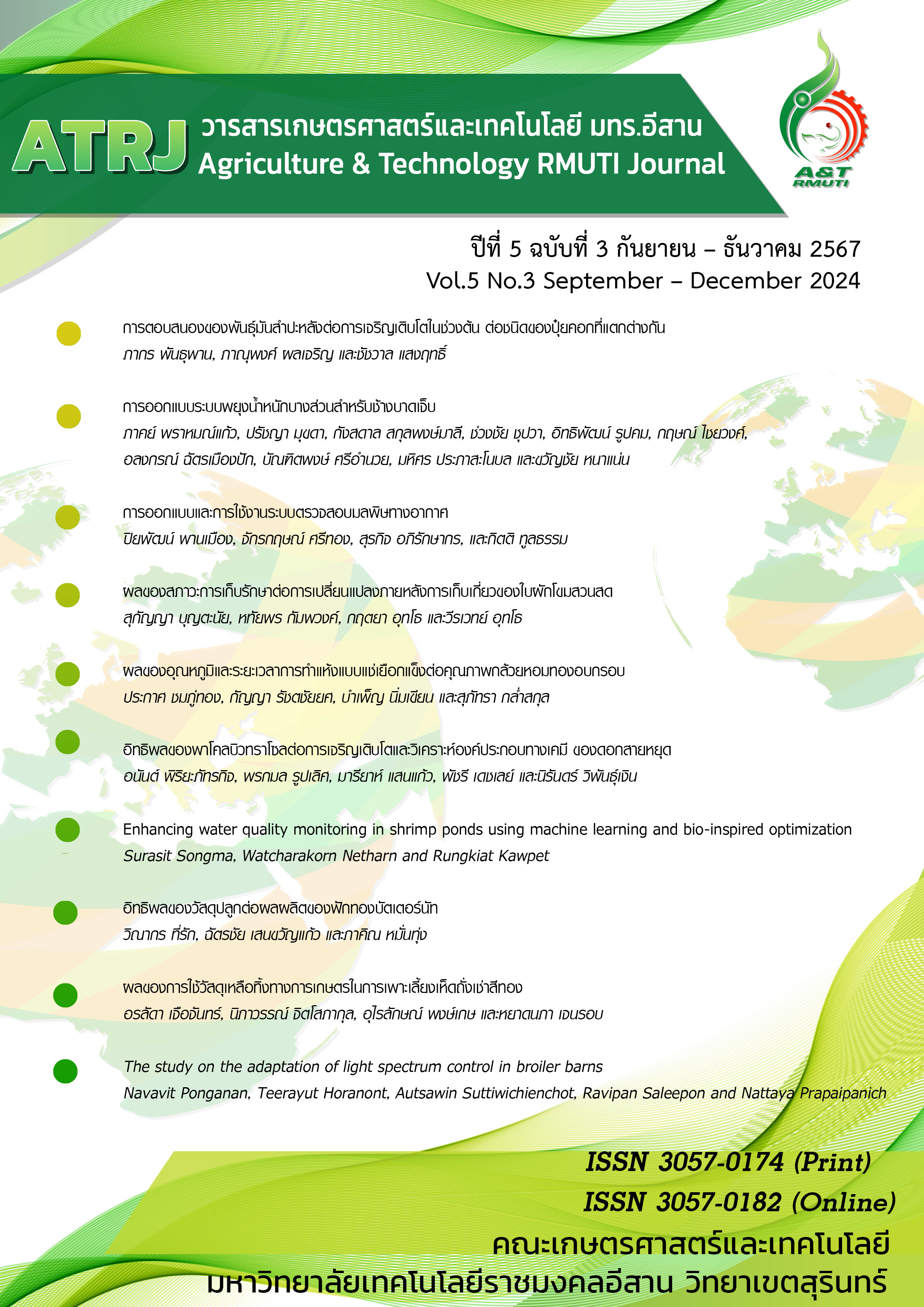Effect of agricultural waste materials utilization for Cordyceps militaris cultivation
Keywords:
Cordyceps militaris, Rice husk, Mature coconut water, Young coconut water, Silk pupaeAbstract
The objective of this research was to study the optimum of solid culture medium for the growth of Cordyceps militaris (C. militaris), as well as the optimal amount of rice husk and coconut water in the culture formula. It was found that the best formula for the growth of C. militaris mycelium is formula 6, which uses chicken eggs mixed with 5% coconut water per 100 milliliters of water. The resulted exhibited in the largest diameter of the C. militaris mycelium at 4.73 centimeters, which was significantly greater
(p≤0.05) than the control (PDA) and other formulas. Using rice husk at concentrations of 0.83%, 1.67%, 2.50%, 3.33%, and 4.17% in the culture medium showed no significant difference (p>0.05) in the number of stalks, fresh weight, and dry weight, but using 2.50% rice husk resulted in the longest mushroom stalks at 7.19 centimeters, which was significantly different (p≤0.05) from the formulas with lower amounts of rice husk. This research also found that adding mature coconut water resulted in a greater number of mushroom stalks, longer stalks, and heavier weight compared to using young coconut water. Moreover, using mature coconut water at 33.33% and 41.67% resulted in the highest number of stalks at 19.67 and 19.33, respectively (p>0.05), and provided the highest weight, significantly different from other samples. It can be observed that using agricultural waste materials, such as rice husk and coconut water affect the growth of C. militaris, with mature coconut water promoting better growth than young coconut water. It is considered the utilization of agricultural waste to be useful, and value added.
References
จิราภา เฉียงพิมาย, เดือนเพ็ญ วงค์สอน, ภาวรินทร์ เพิ่มขุนทด และนิตยา ปิติวิทยากุล. (2564). ผลของเมล็ดธัญพืชต่อการสร้างเส้นใยและการสร้างดอกเห็ดถั่งเช่าสีทอง. ใน การประชุมวิชาการระดับชาติ ราชมงคลสุรินทร์ ครั้งที่ 12 “วิจัยและนวัตกรรมเพื่อพัฒนาเศรษฐกิจวิถีใหม่” 16-17 กันยายน 2564. มหาวิทยาลัยเทคโนโลยีราชมงคลอีสาน วิทยาเขตสุรินทร์. F609-F615.
ณัฐพงษ์ สิงห์ภูงา, พีระศักดิ์ ฉายประสาท และบุญส่ง แสงอ่อน. (2559). ผลของสูตรอาหารเทียมต่อการเกิดดอกและการผลิตสารสำคัญทางยาของเห็ดถั่งเช่าสีทอง. วารสารพืชศาสตร์สงขลานครินทร์. 3(ฉบับพิเศษ III): 34-46.
แพททริค เทรล์. (2566). แกลบ ประโยชน์ 10 ประการเพื่อการเกษตร. ค้นเมื่อ 22 ตุลาคม 2566. https://www.echocommunity.org/th/ resources/9f9bcb3a-ed2e-4209-bf90-38a759ff3340.
ศิวเรศ อารีกิจ. (2564). สายพันธุ์มะพร้าวไทย. บรรยายในงานมหกรรมในหลวงรักเรา ภูมิพลังแผ่นดิน. วันที่ 4 ธันวาคม 2564. ม.ป.ท. 1-6.
สำนักงานเศรษฐกิจการเกษตร. (2566). สถานการ์การผลิตและการตลาดรายสัปดาห์. ค้นเมื่อ 22 ตุลาคม 2566. https://www.oae.go.th/view/1/TH-TH.
อุไรลักษณ์ พงษ์เกษ, นิภาวรรณ์ จิตโสภากุล, อรลัดา เจือจันทร์ และหยาดนภา เจนรอบ. (2564). ผลของชนิดและพันธุ์ข้าวพื้นเมืองสุรินทร์ต่อผลผลิตเห็ดถั่งเช่าสีทอง. ใน การประชุมวิชาการระดับชาติ ราชมงคลสุรินทร์ ครั้งที่ 12 “วิจัยและนวัตกรรมเพื่อพัฒนาเศรษฐกิจวิถีใหม่” 16-17 กันยายน 2564. มหาวิทยาลัยเทคโนโลยีราชมงคลอีสาน วิทยาเขตสุรินทร์. F861-F867.
Akter M., Halawani R.F., Aloufi F.A., Taleb M.A., Akter S. and Mahmood S. (2022). Utilization of agro-industrial wastes for the production of quality oyster mushrooms. Sustainability. 14(2): 1-10.
Baysal E., Peker H., Yalinkiliç M.K. and Temiz A. (2003). Cultivation of oyster mushroom on wastepaper with some added supplementary materials. Bioresource Technology. 89(1): 95-97.
Bonatti M., Karnoppa P., Soaresb H.M. and Furlana S.A. (2004). Evaluation of Pleurotus ostreatus and Pleurotus sajor-caju nutritional characteristics when cultivated in different lignocellulosic wastes. Food Chemistry. 88: 425-428.
Fonseca A.M., Monte F.J.Q., Maria da Conceição F., de Mattos M.C., Cordell G.A., Braz-Filho R. and Lemos T.L. (2009). Coconut water (Cocos nucifera L.)-A new biocatalyst system for organic synthesis. Journal of Molecular Catalysis B: Enzymatic. 57(1-4): 78-82.
Frimpong-Manso J., Obodai M., Dzomeku M. and Apetorgbor M.M. (2011). Influence of rice husk on biological efficiency and nutrient content of Pleurotus ostreatus (Jacq. ex. Fr.) Kummer. International Food Research Journal. 18: 249-254.
Gregori A. (2014). Cordycepin production by Cordyceps militaris cultivation on spent brewery grains. Acta Biological Slovenica. 57(2): 45-52.
Iruoma A.C. and Nduka D.E. (2013). Comparison of sawdust and rice husk as casing materials for Pleurotus pulmonarius propagation on cassava peel substrate. Agriculture and Biology Journal of North America. 4: 552-554.
Jacob J.K.S., Kalaw S.P. and Reyes R.G. (2015). Mycelial growth performance of three species of Pleurotus on coconut water gelatin. Current Research in Environmental & Applied Mycology. 5(3): 263-268.
Juliano B.O. and Tuaño A.P.P. (2019). Gross structure and composition of the rice grain. In rice (pp. 31-53). AACC International Press.
Kim Y.S., Lim J.M., Ku B., Cho H. and Choi J. (2021). Alteration in ginsenoside and cordycepin content by solid-state fermentation of red ginseng with Cordyceps militaris. Accessed 23 Oct. 2023. https://scite.ai/reports/10.17221/149/2020-cjfs.
Nguyen M.P. (2020). Synergistic effect of acoustic and vacuum drying to antioxidant attributes of Cordyceps militaris. Accessed 23 Oct. 2023. https://scite.ai/reports/10.9734/jpri/2020/v32i230399.
Obodai M., Cleland-Okine J. and Vowotor K.A. (2003). Comparative study on the growth and yield of Pleurotus ostreatus mushroom on different lignocellulosic by-products. Journal of Industrial Microbiology and Biotechnology. 30: 146-149.
Oei P. (1996). Mushroom cultivation with special emphasis on appropriate techniques for developing countries. Tool Publications. Leiden. The Netherlands. pp 155.
Osazuwa O.E. and Ahonkhai I. (1989). Coconut water as growth medium for micro-organisms. Nigerian Journal of Palms Oil Seeds. 10(11): 91-95.
Prades A., Dornier M., Diop N. and Pain J.P. (2012). Coconut water uses, composition and properties: a review. Fruits. 67(2): 87-107.
Pramith P. (1998). Oil separation from coconut water by microfiltration method. Rep. No. 62 17. National Food Research Institute. Tsukuba Ibaraki Japan.
Santoso U., Kubo K., Ota T., Tadokoro T. and Maekawa A. (1996). Nutrient composition of kopyor coconuts (Cocos nucifera L.). Food chemistry. 57(2): 299-304.
Shashidhar G.M., Kumar S.S., Giridhar P. and Manohar B. (2017). Antioxidant and cholesterol esterase inhibitory properties of supplementation with coconut water in submerged cultivation of the medicinal Chinese caterpillar mushroom, Ophiocordyceps sinensis CS1197 (Ascomycetes). International Journal of Medicinal Mushrooms. 19(4): 337-345.
Takahashi J.A., Barbosa B.V.R., Martins B.D.A., Guirlanda C.P. and Moura M.A.F.E. (2020). Use of the versatility of fungal metabolism to meet modern demands for healthy aging, functional foods, and sustainability. Accessed 23 Oct. 2023. https://scite.ai/reports/10.3390/jof6040223.
Tan Y.H. and Wahab M.N. (1997). Extracellular enzyme production during anamorphic growth in the edible mushroom, Pleurotus sajor-caju. World Journal of Microbiology and Biotechnology. 13: 613-617.
Thongklang N. and Luangharn T. (2016). Testing agricultural wastes for the production of Pleurotus ostreatus. Mycosphere. 7(6): 766-772.
Ukoima H.N., Ogbonnaya L.O., Arikpo G.E. and Ikpe F.N. (2009). Cultivation of mushroom (Volvariella volvacea) on various farm wastes in obubra local government of cross river state, Nigeria. Pakistan Journal of Nutrition. 8(7): 1059-1061.
Walter E.H.M., Nascimento M.S. and Kuaye A.Y. (2009). Efficacy of sodium hypochlorite and peracetic acid in sanitizing green coconuts. Letters in Applied Microbiology. 49: 366-371.
Wazir S.K.S. (1997). Technologies on environment–friendly young tender coconuts. in Proceeding COCOTECH Meeting. Asia-Pacific Coconut Community. Manila. Philippines.
Xie C.Y., Gu Z.X. and Fan G.J. (2009). Production of cordycepin and mycelia by submerged fermentation of Cordyceps militaris in mixture natural culture. Applied Biochemistry and Biotechnology. 158: 483-492.
Downloads
Published
How to Cite
Issue
Section
License
Copyright (c) 2024 Agriculture & Technology RMUTI Journal

This work is licensed under a Creative Commons Attribution-NonCommercial-NoDerivatives 4.0 International License.
เนื้อหาและข้อมูลในบทความที่ลงตีพิมพ์ในวารสารทดสอบระบบ ThaiJo2 ถือเป็นข้อคิดเห็นและความรับผิดชอบของผู้เขียนบทความโดยตรงซึ่งกองบรรณาธิการวารสาร ไม่จำเป็นต้องเห็นด้วย หรือร่วมรับผิดชอบใดๆ
บทความ ข้อมูล เนื่อหา รูปภาพ ฯลฯ ที่ได้รับการดีพิมพ์ในวารสารทดสอบระบบ ThaiJo2 ถือเป็นลิขสิทธิ์ของวารสารทดสอบระบบ ThaiJo2 หากบุคคลหรือหน่วยงานใดต้องการนำทั้งหมดหรือส่วนหนึ่งส่วนใดไปเผยแพร่หรือเพื่อกระทำการใดๆ จะต้องได้รับอนุญาตเป็นลายลักอักษรณ์จากวารสารทดสอบระบบ ThaiJo2 ก่อนเท่านั้น






